![]() When Olivier Cussac received word that Studio Condorcet – a recording facility near the centre of Toulouse founded in the 1970s, and that he had owned since 2007 – was scheduled for demolition as part of an urban renewal project, he stepped in to save it. This year has seen it reborn in with a Harrison 32Classic 32-channel analogue console as the first of several planned spaces at a new location just outside Toulouse.
When Olivier Cussac received word that Studio Condorcet – a recording facility near the centre of Toulouse founded in the 1970s, and that he had owned since 2007 – was scheduled for demolition as part of an urban renewal project, he stepped in to save it. This year has seen it reborn in with a Harrison 32Classic 32-channel analogue console as the first of several planned spaces at a new location just outside Toulouse.
Cussac, a multi-instrumentalist, engineer, producer and film/TV composer, ‘absolutely wanted a brand-new desk but was unfamiliar with the brand other than the Mixbus software. ‘My interest started to grow when I saw the pedigree of the studios and engineers who used the 32C,’ he says.
‘As a film score composer, I have to work in various musical styles, from orchestral to jazz to electro to every kind of pop, rock and funk styles. As a record producer, I really focus on the intensity in music, no matter the genre. The 32Classic can handle anything; a heavy rock band like Slift, all the way to a fully acoustic project.’
 Cussac worked on the last album from Tolouse-based Slift at the studio’s previous location, and has been working with the band on pre-production for their next project on the new console.
Cussac worked on the last album from Tolouse-based Slift at the studio’s previous location, and has been working with the band on pre-production for their next project on the new console.
‘All the drums went through the 32Classic mic preamps and I can tell you – they rock. I was used to miking drums with vintage mic preamps and the 32Classic has the same punch and density.
‘I’m not an EQ guy, so I mostly rely on my favourite inductor-based outboard gear, and the proportional Q on the Harrison gives me some of the same feeling. The summing adds depth and width, with lots of headroom. The transformer option on the bus master is subtle but can add some mojo to mixes.’
In Studio Condorcet’s large mix room, Cussac is surrounded by guitars and keyboards, and has views of the countryside through a large window next to the console. The room’s acoustic design is by Camille Hamel and Jean Marc Vernaudon, and allows it to double as a recording space. The high-ceilinged room beyond the front wall is currently being converted into a tracking space for bands or ensembles of up to 15 musicians.
Before deciding on the Harrison desk, Cussac had been considering several console brands, but a visit to Harrison’s international manufacturing facility in the UK with his technician, Julien Couralet, sealed the deal. They had brought along a multitrack project so they could compare the quality of the 32Classic’s summing to Couralet’s vintage console. ‘It was quite easy to recall levels with the 0dB lock button on each channel, which bypasses the fader and sets the level to exactly 0dB,’ he says. ‘Both versions sounded great, but the 32Classic was a bit beefier. Mids for me are the key.
 ‘I really consider the LPF as a creative tool; you could even call it a “poetic” tool,’ he continues. ‘A regular LPF coldly removes part of the sound, whereas Harrison’s filters add something musical while cutting in a kind of magical way. It reminds me of the filter behaviour of some of my favourite vintage analogue synths.’
‘I really consider the LPF as a creative tool; you could even call it a “poetic” tool,’ he continues. ‘A regular LPF coldly removes part of the sound, whereas Harrison’s filters add something musical while cutting in a kind of magical way. It reminds me of the filter behaviour of some of my favourite vintage analogue synths.’
He also appreciates other aspects of the desk design, such as the deep arm rest and custom sidecar on the right-hand end of the console. ‘The D-sub patching at the rear is also a nice feature as they are angled down so they are not stressed by the weight of the cables, and there’s a lot with an analogue patchbay,’ he says. ‘I wanted a fully analogue console with a full analogue patchbay, so I chose not to have the Dante AD/DA audio interface included.’
One other small feature stands out: ‘The instrument input in the centre section. I initially considered it a gadget but have unexpectedly been very happy with it. Being able to patch a mic or a keyboard on the fly is always helpful.’
Cussac’s first project in the new space was mixing an album for French trumpet player Daoud. ‘Fifteen tracks mixed in five days with no recall and no mods,’ he reports. He has since completed two more albums – Julii Sharp’s Burning Line and Words of Sara’s Echoes from the Living – at the new Studio Condorcet. ‘The Harrison console, ATC 110 monitors and fine acoustic design plus top backline make this studio an exceptional environment to create and record music.’
More: www.harrisonconsoles.com